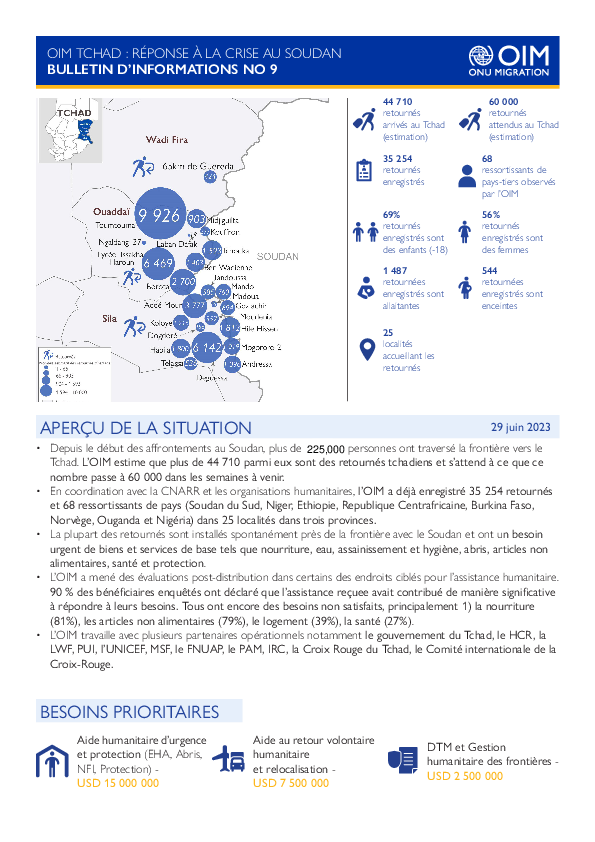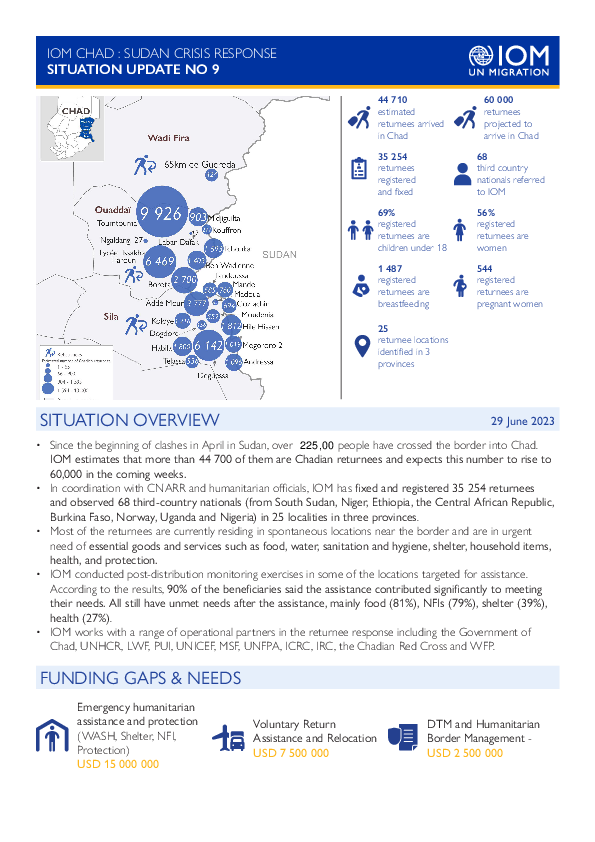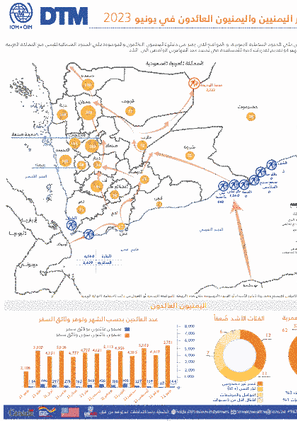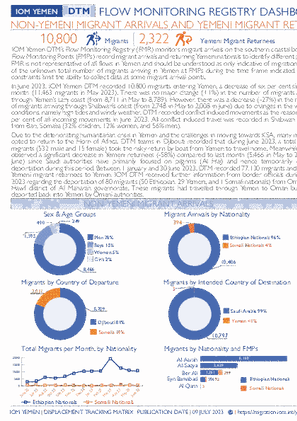-
Countries
-
Data and Analysis
-
Special Focus
-
Crisis Responses

Contact
DTM Chad, dtmtchad@iom.int
Language
French
Location
Chad
Period Covered
Jun 29 2023
Jun 29 2023
Activity
- Flow Monitoring Survey
- Flow Monitoring
Depuis le début des affrontements au Soudan, plus de 180 000 personnes ont traversé la frontière vers le Tchad. L’OIM estime que plus de 44 710 parmi eux sont des retournés tchadiens et s’attend à ce que ce nombre passe à 60 000 dans les semaines à venir.
En coordination avec la CNARR et les organisations humanitaires, l’OIM a déjà enregistré 35 254 retournés et 68 ressortissants de pays (Soudan du Sud, Niger, Ethiopie, Republique Centrafricaine, Burkina Faso, Norvège, Ouganda et Nigéria) dans 25 localités dans trois provinces. La plupart des retournés sont installés spontanément près de la frontière avec le Soudan et ont un besoin urgent de biens et services de base tels que nourriture, eau, assainissement et hygiène, abris, articles non alimentaires, santé et protection.
L’OIM a mené des évaluations post-distribution dans certains des endroits ciblés pour l’assistance humanitaire. 90 % des bénéficiaires enquêtés ont déclaré que l’assistance reçuee avait contribué de manière significative à répondre à leurs besoins. Tous ont encore des besoins non satisfaits, principalement 1) la nourriture (81%), les articles non alimentaires (79%), le logement (39%), la santé (27%).
L’OIM travaille avec plusieurs partenaires opérationnels notamment le gouvernement du Tchad, le HCR, la LWF, PUI, l’UNICEF, MSF, le FNUAP, le PAM, IRC, la Croix Rouge du Tchad, le Comité internationale de la Croix-Rouge.

Contact
DTM Chad, dtmtchad@iom.int
Language
English
Location
Chad
Period Covered
Jun 29 2023
Jun 29 2023
Activity
- Flow Monitoring Survey
- Flow Monitoring
Since the beginning of clashes in April in Sudan, over 180,000 people have crossed the border into Chad. IOM estimates that more than 44 700 of them are Chadian returnees and expects this number to rise to 60,000 in the coming weeks.
In coordination with CNARR and humanitarian officials, IOM has fixed and registered 35 254 returnees and observed 68 third-country nationals (from South Sudan, Niger, Ethiopia, the Central African Republic, Burkina Faso, Norway, Uganda and Nigeria) in 25 localities in three provinces. Most of the returnees are currently residing in spontaneous locations near the border and are in urgent need of essential goods and services such as food, water, sanitation and hygiene, shelter, household items, health, and protection.
IOM conducted post-distribution monitoring exercises in some of the locations targeted for assistance. According to the results, 90% of the beneficiaries said the assistance contributed significantly to meeting their needs. All still have unmet needs after the assistance, mainly food (81%), NFIs (79%), shelter (39%), health (27%).
IOM works with a range of operational partners in the returnee response including the Government of Chad, UNHCR, LWF, PUI, UNICEF, MSF, UNFPA, ICRC, IRC, the Chadian Red Cross and WFP
Contact
DTM Yemen, iomyemendtm@iom.int
Location
Yemen
Activity
- Mobility Tracking
- Event Tracking
Period Covered
Jul 02 2023 -Jul 08 2023
From 1 January to 8 July 2023, IOM Yemen DTM tracked 3,551 households (HH) (21,306 Individuals) who experienced displacement at least once.
Between 2 and 8 July 2023, IOM Yemen DTM tracked 34 households (204 individuals) displaced at least once. The majority of people moved into/within the following governorates and districts:
- Al Hodeidah (13 HHs) – Hays (13 HHs) district. Most displacements in the governorate were internal.
- Ma’rib (12 HHs) – Ma’rib (8 HHs), Harib (3 HHs), Ma’rib City (1 HH) districts. Most displacements in the governorate originated from Ma’rib and Al Bayda.
- Ta’iz (6 HHs) – Jabal Habashi (3 HHs), Ash Shamayatayn (3 HHs) districts. All displacements in the governorate were internal.
- Al Hodeidah (13 HHs) – Hays (6 HHs), Jabal Ras (5 HHs), Al Jarrahi (2 HHs) districts.
- Ta’iz (8 HHs) – Maqbanah (3 HHs), Al Maafer (2 HHs), Ash Shamayatayn (1 HH) districts.
- Ma’rib (4 HHs) – Al Jubah (3 HHs), Raghwan (1 HH) districts.
Population Groups
Survey Methodology
Unit of Analysis Or Observation
Type of Survey or Assessment
Keywords
Geographical Scope
Administrative boundaries with available data
The current dataset covers the following administrative boundaries

Contact
DTM Yemen, iomyemendtm@iom.int
Language
English
Location
Yemen
Period Covered
Jul 02 2023
Jul 08 2023
Activity
- Rapid Emergency Registration
- Mobility Tracking
IOM Yemen DTM’s Rapid Displacement Tracking (RDT) tool collects data on estimated numbers of households forced to flee on a daily basis from their locations of origin or displacement, allowing for regular reporting of new displacements in terms of estimated numbers, geography, and needs. It also tracks returnees who returned to their location of origin.
From 1 January to 8 July 2023, IOM Yemen DTM tracked 3,551 households (HH) (21,306 Individuals) who experienced displacement at least once.
Between 2 and 8 July 2023, IOM Yemen DTM tracked 34 households (204 individuals) displaced at least once. The majority of people moved into/within the following governorates and districts:
- Al Hodeidah (13 HHs) – Hays (13 HHs) district. Most displacements in the governorate were internal.
- Ma’rib (12 HHs) – Ma’rib (8 HHs), Harib (3 HHs), Ma’rib City (1 HH) districts. Most displacements in the governorate originated from Ma’rib and Al Bayda.
- Ta’iz (6 HHs) – Jabal Habashi (3 HHs), Ash Shamayatayn (3 HHs) districts. All displacements in the governorate were internal.
The majority of people moved from the following governorates and districts:
- Al Hodeidah (13 HHs) – Hays (6 HHs), Jabal Ras (5 HHs), Al Jarrahi (2 HHs) districts.
- Ta’iz (8 HHs) – Maqbanah (3 HHs), Al Maafer (2 HHs), Ash Shamayatayn (1 HH) districts.
- Ma’rib (4 HHs) – Al Jubah (3 HHs), Raghwan (1 HH) districts.

Contact
DTM Iraq, IraqDTM@iom.int
Language
English
Location
Iraq
Period Covered
Jan 01 2023
Apr 30 2023
Activity
- Mobility Tracking
- Baseline Assessment
Since 2014, the International Organization for Migration’s (IOM) Displacement Tracking Matrix (DTM) unit in Iraq has collected information on internally displaced persons (IDPs) and returnees using a network of key informants across the country.1 Master List data are collected continuously and reported on a quarterly basis. Data for this round were collected from 1 January to 30 April 2023.
Contact
iomyemendtm@iom.int
Location
Yemen
Activity
- Flow Monitoring Survey
- Flow Monitoring
Period Covered
Jun 01 2023 -Jun 30 2023
In June 2023, IOM Yemen DTM recorded 10,800 migrants entering Yemen, a decrease of six per cent since last month (11,463 migrants in May 2023). There was no major change (+1%) in the number of migrants arriving through Yemen's Lahj coast (from 8,711 in May to 8,789). However, there was a decrease (-27%) in the number of migrants arriving through Shabwah's coast (from 2,748 in May to 2,008 in June) due to changes in the weather conditions, namely high tides and windy weather. DTM recorded conflict induced movements as the reason for 15 per cent of all incoming movements in June 2023. All conflict induced travel was recorded in Shabwah coming from Bari, Somalia (32% children, 12% women, and 56% men).
Due to the deteriorating humanitarian crisis in Yemen and the challenges in moving towards KSA, many migrants opted to return to the Horn of Africa. DTM teams in Djibouti recorded that during June 2023, a total of 547 migrants (532 male and 15 female) took the risky return by boat from Yemen to travel home. Meanwhile, DTM observed a significant decrease in Yemeni returnees (-58%) compared to last month (5,466 in May to 2,322 in June) since Saudi authorities have primarily focused on pilgrims (Al Haj) and hence temporarily delayed deportation during this period.
Between 1 January and 30 June 2023, DTM recorded 77,130 migrants and 27,078 Yemeni migrant returnees to Yemen.
IOM DTM received further information from border officials during June 2023 regarding the deportation of 80 migrants (50 Ethiopian, 29 Yemeni, and 1 Somali nationals) from Oman into Hawf district of Al Maharah governorate. These migrants had travelled through Yemen to Oman but were deported back into Yemen by Omani authorities.
Population Groups
Survey Methodology
Unit of Analysis Or Observation
Type of Survey or Assessment
Keywords
Geographical Scope
Administrative boundaries with available data
The current dataset covers the following administrative boundaries

Contact
IOM DTM Yemen, iomyemendtm@iom.int
Language
English
Location
Yemen
Period Covered
Jun 01 2023
Jun 30 2023
Activity
- Flow Monitoring
لا يشمل سجل مراقبة التدفق جميع نقاط التدفق في اليمن، ولكنه يمثل مؤشراً حول اتجاهات الهجرة بالنسبة لإجمالي العدد غير المعروف للمهاجرين الوافدين إلى اليمن عبر نقاط التدفق خلال الإطار الزمني المحدد. والجدير بالذكر أن القيود المفروضة على الوصول تَحُد من القدرة على جمع البيانات في بعض نقاط وصول المهاجرين.
لاحظت مصفوفة تتبع النزوح التابعة للمنظمة الدولية للهجرة في اليمن دخول 10,800 مهاجر إلى اليمن في يونيو 2023 ، بانخفاض قدره 6٪ عن الشهر السابق (11,463 مهاجرًا في مايو 2023). سجلت مصفوفة تتبع النزوح ارتفاعًا بنسبة 1٪ في عدد الوافدين إلى لحج (8,789 مهاجرًا) مقارنة بالشهر السابق (8,711). من ناحية أخرى ، انخفض عدد المهاجرين الوافدين عبر ساحل شبوة (- 27٪) (من 2748 في مايو إلى 2،008 في يونيو) بسبب التغيرات في الأحوال الجوية مما أدى إلى صعوبة التنقل في المد والجزر والرياح القوية. في يونيو 2023 ، وثقت مصفوفة تتبع النزوح الحركات الناجمة عن الصراع باعتبارها سبب 15٪ من جميع الحركات القادمة. تم تسجيل جميع الرحلات المتعلقة بالنزاع والقادمة من باري، الصومال في محافظة شبوة (32٪ أطفال ، 12٪ نساء، و 56٪ رجال).
بسبب الوضع الإنساني المتنامي في اليمن وصعوبة الوصول إلى المملكة العربية السعودية ، يختار العديد من المهاجرين العودة إلى القرن الأفريقي. لاحظ موظفو مصفوفة تتبع النزوح في جيبوتي أن 547 مهاجرًا (532 ذكرًا و 15 أنثى) أخذوا رحلة العودة المحفوفة بالمخاطر بالقارب من اليمن للعودة إلى الوطن خلال يونيو 2023. وفي الوقت نفسه ، لاحظت مصفوفة تتبع النزوح انخفاضًا كبيرًا في عدد اليمنيين العائدين (-58٪) مقارنة بالشهر الماضي (من 5,466 في مايو إلى 2,322 في يونيو) نظرًا لأن السلطات السعودية ركزت بشكل أساسي على الحجاج وبالتالي أوقفت الترحيل مؤقتًا خلال هذه الفترة. مابين الفترة من 1 يناير إلى 30 يونيو 2023 ، وثقت مصفوفة تتبع النزوح عدد 77,130 مهاجراً و 27,078 عائداً يمني. كما تلقت مصفوفة تتبع النزوح خلال شهر يونيو 2023، مزيدًا من المعلومات من مسؤولي الحدود اليمنية العمانية حول ترحيل 80 مهاجراً (50 اثيوبياً و 29 يمنياً و 1 صومالي) من عمان إلى منطقة حوف بمحافظة المهرة. كان هؤلاء المهاجرون قد شقوا طريقهم من اليمن إلى عمان

Contact
IOM DTM Yemen, iomyemendtm@iom.int
Language
English
Location
Yemen
Period Covered
Jun 01 2023
Jun 30 2023
Activity
- Flow Monitoring
FMR is not representative of all flows in Yemen and should be understood as only indicative of migration trends of the unknown total number of migrants arriving in Yemen at FMPs during the time frame indicated. Access constraints limit the ability to collect data at some migrant arrival points.
In June 2023, IOM Yemen DTM recorded 10,800 migrants entering Yemen, a decrease of six per cent since last month (11,463 migrants in May 2023). There was no major change (+1%) in the number of migrants arriving through Yemen’s Lahj coast (from 8,711 in May to 8,789). However, there was a decrease (-27%) in the number of migrants arriving through Shabwah’s coast (from 2,748 in May to 2,008 in June) due to changes in the weather conditions, namely high tides and windy weather. DTM recorded conflict induced movements as the reason for 15 per cent of all incoming movements in June 2023. All conflict induced travel was recorded in Shabwah coming from Bari, Somalia (32% children, 12% women, and 56% men).
Due to the deteriorating humanitarian crisis in Yemen and the challenges in moving towards KSA, many migrants opted to return to the Horn of Africa. DTM teams in Djibouti recorded that during June 2023, a total of 547 migrants (532 male and 15 female) took the risky return by boat from Yemen to travel home. Meanwhile, DTM observed a significant decrease in Yemeni returnees (-58%) compared to last month (5,466 in May to 2,322 in June) since Saudi authorities have primarily focused on pilgrims (Al Haj) and hence temporarily delayed deportation during this period. Between 1 January and 30 June 2023, DTM recorded 77,130 migrants and 27,078 Yemeni migrant returnees to Yemen. IOM DTM received further information from border officials during June 2023 regarding the deportation of 80 migrants (50 Ethiopian, 29 Yemeni, and 1 Somali nationals) from Oman into Hawf district of Al Maharah governorate. These migrants had travelled through Yemen to Oman but were deported back into Yemen by Omani authorities.
Contact
DTM Iraq, IraqDTM@iom.int
Location
Iraq
Activity
- Mobility Tracking
- Baseline Assessment
Period Covered
Jan 01 2023 -Apr 30 2023
The IDP and Returnees Master Lists collect information on numbers and locations of IDP and returnee families through an ongoing data collection system that identifies and routinely updates figures through contacts with key informants. The unit of observation is the location.
Master Lists are fully updated in one calendar month, which means that information on all locations is updated once a month. In two weeks, approximately 50% of the locations are updated, data is sent to the IOM Information Management Unit, and the dataset with partial updates is released after quality control, while the teams continue to update information from the remaining locations. By the end of the month, the update is complete and the DTM report is published with fully updated information on IDPs and returnees.
Core information routinely collected is:
- Geographical (governorate, district, sub-district, location and GPS coordinates of the place of displacement/return where the population is identified).
- Governorate of origin for IDPs, and governorate of last displacement for returnees.
- Wave of displacement (the DTM conventionally identifies six displacement waves or periods: pre-June 2014; June-July 2014; August 2014; post-September 2014; Post April 2015; and Post March 2016 onwards).
- Shelter type (the DTM identifies four shelter category: Camps; critical shelter arrangements (informal settlements, religious buildings, schools; unfinished or abandoned buildings; and other formal settlements/ collective centers); private dwellings (host communities, rented houses, and hotels/motels); and unknown (applies to locations not accessible when the shelter type cannot be identified).
The DTM Master lists also collect additional operational information:
- Name, position and contact details of the key informant.
- Status of the update (i.e. new location; old location with updated information weather changed or unchanged; or not assessed in the current round).
- Date of the update.
- Location accessibility.
- Notes from the field.
The Master Lists collects information on the total number of families displaced or returned to a location at the time of data collection, not on new cases. Therefore, at every round of updates, the new count replaces the old count. The new count can be lower/higher than the previous count if the inflow is smaller/bigger than the outflow, or it can be zero if all IDPs/returnees left the place where they were previously identified. Once a location stops hosting IDPs or returnees, the DTM does not track personal IDP movements; that is, if specific families returned home, moved to a different shelter in the same location, or moved to a different location still away from home. Instead, the DTM methodology is designed to regularly monitor and update all IDP locations, thus enabling a continuous countrywide coverage of the main characteristics of the IDP population.
The IDP Master List was launched in December 2013 and the Returnee Master List in April 2015 (although returnee figures have been retroactively reported since October 2014).
Population Groups
Survey Methodology
Unit of Analysis Or Observation
Type of Survey or Assessment
Keywords
Geographical Scope
Administrative boundaries with available data
The current dataset covers the following administrative boundaries
Contact
DTM Iraq, IraqDTM@iom.int
Location
Iraq
Activity
- Mobility Tracking
- Baseline Assessment
Period Covered
Jan 01 2023 -Apr 30 2023
The IDP and Returnees Master Lists collect information on numbers and locations of IDP and returnee families through an ongoing data collection system that identifies and routinely updates figures through contacts with key informants. The unit of observation is the location.
Master Lists are fully updated in one calendar month, which means that information on all locations is updated once a month. In two weeks, approximately 50% of the locations are updated, data is sent to the IOM Information Management Unit, and the dataset with partial updates is released after quality control, while the teams continue to update information from the remaining locations. By the end of the month, the update is complete and the DTM report is published with fully updated information on IDPs and returnees.
Core information routinely collected is:
- Geographical (governorate, district, sub-district, location and GPS coordinates of the place of displacement/return where the population is identified).
- Governorate of origin for IDPs, and governorate of last displacement for returnees.
- Wave of displacement (the DTM conventionally identifies six displacement waves or periods: pre-June 2014; June-July 2014; August 2014; post-September 2014; Post April 2015; and Post March 2016 onwards).
- Shelter type (the DTM identifies four shelter category: Camps; critical shelter arrangements (informal settlements, religious buildings, schools; unfinished or abandoned buildings; and other formal settlements/ collective centers); private dwellings (host communities, rented houses, and hotels/motels); and unknown (applies to locations not accessible when the shelter type cannot be identified).
The DTM Master lists also collect additional operational information:
- Name, position and contact details of the key informant.
- Status of the update (i.e. new location; old location with updated information weather changed or unchanged; or not assessed in the current round).
- Date of the update.
- Location accessibility.
- Notes from the field.
The Master Lists collects information on the total number of families displaced or returned to a location at the time of data collection, not on new cases. Therefore, at every round of updates, the new count replaces the old count. The new count can be lower/higher than the previous count if the inflow is smaller/bigger than the outflow, or it can be zero if all IDPs/returnees left the place where they were previously identified. Once a location stops hosting IDPs or returnees, the DTM does not track personal IDP movements; that is, if specific families returned home, moved to a different shelter in the same location, or moved to a different location still away from home. Instead, the DTM methodology is designed to regularly monitor and update all IDP locations, thus enabling a continuous countrywide coverage of the main characteristics of the IDP population.
The IDP Master List was launched in December 2013 and the Returnee Master List in April 2015 (although returnee figures have been retroactively reported since October 2014).
Population Groups
Survey Methodology
Unit of Analysis Or Observation
Type of Survey or Assessment
Keywords
Geographical Scope
Administrative boundaries with available data
The current dataset covers the following administrative boundaries